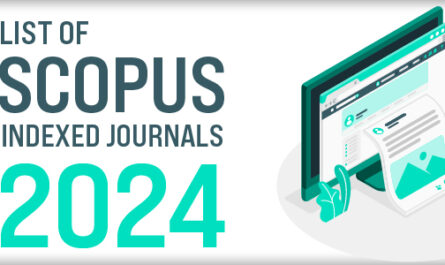The entire prospect of academic publishing is fraught with unique challenges, especially when identifying journals that are both affordable and swift in their publication processes. This blog aims to guide researchers through the landscape of Scopus-indexed journals 2024, highlighting key strategies to detect journals that prioritize both cost-efficiency and speedy publication. By focusing on these criteria, academics can effectively disseminate their research without compromising on quality or financial resources.
The Appeal Of Fast Publishing & Low Cost
- The urgency for timely and cost-effective dissemination of research findings has never been more pronounced.
- As scholars strive to advance their careers and contribute to their fields, the mechanisms through which they publish have become pivotal to their professional success.
- This section delves into the critical facets of fast publishing and low costs in academic journals, particularly those indexed in prestigious databases like Scopus and Web of Science.
- The focus is on understanding why these aspects are increasingly sought after by researchers across various disciplines.
What Drives The Demand For Fast Publishing In Academic Journals?
Accelerating Professional Milestones
- For many academics, especially those early in their careers or near pivotal evaluations such as tenure review, the speed at which their work is published can significantly impact their career progression.
- Fast publication timelines allow researchers to disseminate their findings promptly, ensuring timely citation and recognition which are crucial for career advancement.
Grant Funding & Project Timelines
- Researchers working on time-sensitive projects, often funded by grants, may have deadlines by which their results need to be published.
- Quick publication processes help meet these deadlines and prove the viability of their findings, which is essential for securing future funding.
Keeping Pace With Rapidly Evolving Fields
- In fields such as technology and medicine, where new discoveries and innovations occur swiftly, rapid publication ensures that findings remain relevant and can be built upon by others in the discipline.
- Delay in publishing can render research obsolete, negating its potential impact on the field.
How Does Low Cost Impact The Accessibility Of Academic Publishing?
Enabling Broader Participation
- The high costs associated with publishing in well-regarded journals can be a barrier for researchers from low-income countries or institutions with limited resources.
- Affordable publishing options democratize the ability to contribute to scientific conversations, allowing a more diverse array of voices to be heard.
Conservation Of Research Budgets
- Researchers often operate within tight budget constraints.
- Journals that offer low-cost publication options enable scholars to allocate more of their funds towards their research activities rather than the dissemination of their results, thus supporting more robust and comprehensive projects.
Facilitating Multiple Publications
- Lower publication costs make it feasible for researchers to publish multiple articles, disseminating various aspects of their research more comprehensively.
- This is particularly important for complex studies that require detailed explanation spread across several publications.
Where Do Fast-Publishing, Low-Cost Journals Stand In 2024?
- In 2024, the landscape of academic publishing continues to evolve with an increasing number of journals indexed in databases like Scopus and the Web of Science journals 2024 offering streamlined, cost-effective publication processes.
- These journals have adopted innovative peer-review models and digital publishing technologies that reduce overheads and accelerate the publication timeline.
- The integration of artificial intelligence in manuscript screening and editing further enhances the speed and reduces costs, making these journals attractive venues for publication.
How Can Researchers Identify & Utilize These Journals?
- To spot journals that offer both rapid publication and low costs, researchers should consult the latest Web of Science journals 2024 list and check for Scopus indexing.
- These resources provide updated information on journal impact factors, acceptance to publication times, and open access fees, guiding researchers in making informed decisions.
Evaluating Journal Policies
- Beyond indexing, researchers should review the journal’s policies on manuscript handling and publication charges.
- Transparency in these areas is often indicative of the journal’s commitment to supporting scholarly communication in a timely and affordable manner.
Networking & Academic Platforms
- Engaging with the academic community through conferences and online platforms can also provide insights into Web of Science journals 2024 Scopus reputations and practices, aiding researchers in choosing the right outlet for their work.
Analyzing Publishing Speed
- A keen understanding of the intricacies involved in the publication process, particularly the speed of publication is important.
- This section examines how researchers can effectively determine the actual publication timelines of journals indexed in significant databases like Scopus and Web of Science.
- The focus is squarely on identifying journals that not only promise but also deliver quick publication cycles, thereby facilitating timely scholarly communication.
What Constitutes The Publishing Speed Of A Journal?
Defining Publication Speed
- Publication speed typically refers to the duration from manuscript submission to its eventual publication.
- This period encompasses several phases, including initial submission, peer review, post-review revisions, acceptance, and finally, the appearance of the article in a journal.
- Speed is often a critical factor for researchers who are under time constraints due to upcoming project deadlines or performance evaluations.
Components Impacting Speed
- Several factors contribute to the speed of publication, such as the efficiency of the peer review process, the responsiveness of the authors to revision requests, and the journal’s backlog of accepted articles waiting to be published.
- Understanding these components can help researchers set realistic expectations and select the right journal for submission.
How Can Researchers Assess The Publishing Speed Of Web Of Science Journals Fast Publication Scopus Indexed?
Checking Journal Metrics
- One initial step is to consult specific metrics like the median time to first decision and the median time to publication, which are often listed on the journal’s website or in its submission guidelines.
- These metrics provide a ballpark figure but should be viewed critically, as they can be influenced by various factors, including submission volume and journal policies.
Reading Author Testimonials
- Insights from other researchers who have published in the web of science journals fast publication can be invaluable.
- Many academic forums and websites feature discussions where authors share their experiences regarding the publication speed of specific journals.
Analyzing Recent Issues
- A practical approach is to examine the publication dates and submission dates of articles in recent issues, if available.
- This direct method gives a clear picture of the current lag time in publication.
What Are The Potential Misleads When Evaluating Publishing Speed?
Editorial Overpromises
- Sometimes, journals may advertise shorter processing times during promotional periods or to attract submissions, which may not accurately reflect the usual publication speed.
Variability Across Disciplines
- The standard timelines for publication can vary significantly between different fields of study.
- For instance, journals dealing with fast-paced industries such as technology and medicine might have quicker review processes compared to those in humanities.
Impact Of Special Issues
- Special issues can either accelerate or delay publication times.
- Articles aligned with the theme of a special issue might be processed faster to coincide with specific events or milestones.
Where To Find Reliable Data On Fast-Publishing Journals?
Journal Websites & Their Historical Data
- Most journals prominently display their average review times and acceptance rates on their websites.
- Prospective authors should look for trends in these metrics over the past years to gauge consistency.
Database Filters
- Utilizing databases like Web of Science and Scopus, researchers can filter journals based on the median duration from submission to publication.
- These platforms often provide up-to-date and reliable data that can be crucial in selecting a journal.
Academic Social Networks
- Platforms like ResearchGate and Academia.edu allow researchers to interact directly and share their personal experiences regarding different journals’ review processes.
Decoding Publication Fees
- The cost of publishing academic articles has always been a significant concern for researchers, particularly those from underfunded institutions or countries.
- Understanding the structures of publication fees in Scopus indexed journals and their justification involves not just identifying the amount but also assessing the value provided in return.
- This exploration seeks to unravel the complexities of publication fees, aiding researchers in making informed decisions about where to submit their work for a balance of cost, speed, and exposure.
What Are The Common Structures Of Publication Fees In Scopus Journals?
Types Of Fees Explained
- Most journals charge some form of publication fee, often termed as article processing charges (APCs), which cover the costs of the publication process including peer review, journal overhead, and sometimes open access provision.
- These fees can vary widely based on the journal’s reputation, impact factor, and the financial model it operates under (subscription-based vs. open access).
Range Of Fees
- In fast publishing Scopus indexed journals in multidisciplinary fields, the fees can range from a few hundred to several thousand dollars.
- The variation is often reflective of the journal’s reach, quality of peer review, and the perceived value of its impact factor.
- Web of Science indexed pharmacy journals Scopus, for example, may have different pricing structures depending on their targeted academic audience and their operational costs.
How Can Researchers Determine If Publication Fees Are Justified?
Assessing Fee Transparency
- Journals should provide clear, upfront information about all costs associated with publication.
- This includes not only the APCs but also potential fees for extra pages, color figures, or supplementary materials.
- Transparency in these fees is often a good indicator of the journal’s legitimacy and ethical standards.
Evaluating Value For Money
- Researchers should consider what the publication fee entails.
- Does it include open access?
- Are there fast-tracking options for peer review?
- Journals that offer additional services like professional copyediting, extensive dissemination, or inclusion in major databases (such as Scopus or Web of Science) might justify higher fees.
Comparing Journals Within The Same Field
- By examining similar journals within a discipline, researchers can gauge whether a fee is reasonable.
- If a journal charges significantly more than its contemporaries without offering clear advantages, the fee may not be justified.
Where Can Researchers Find Information About Publication Fees?
Journal Websites
- The first and most direct source of information is the journal’s own website.
- Most reputable journals clearly outline their fee structures under a specific section (often called ‘Author Fees’ or ‘APC Information’).
Publisher Correspondence
- Researchers can directly contact the publisher for detailed explanations of the fee structure, especially if the information is not transparent on the journal’s website.
Academic Networks
- Discussions on academic social networks like ResearchGate or forums can provide insider perspectives on whether the fees charged by certain journals are justified based on the services provided.
What Should Researchers Watch Out For When Dealing With Publication Fees?
Unexpected Charges
- Some journals might have hidden costs not immediately apparent.
- It’s important to read the fine print related to terms of publication.
Predatory Practices
- High fees without corresponding value (like rapid, rigorous peer review and dissemination) might be a sign of predatory journals.
- Researchers should be wary of journals that guarantee acceptance or extremely rapid publication for high fees.
Institutional Support
- Researchers should check if their institution offers subsidies or supports publishing in open access journals, which can offset high APCs.
Selecting the right journal for publishing research can significantly impact the dissemination and reception of your work within the academic community. By applying the insights and methods discussed in this blog, researchers can identify Scopus indexed journals that offer both rapid publication timelines and low costs. This ensures that their findings are shared timely and widely, while also preserving their budget for other essential research activities in 2024.




